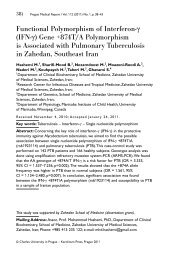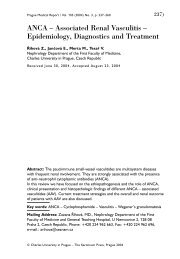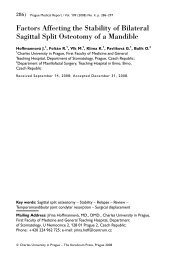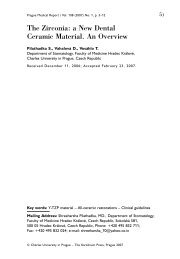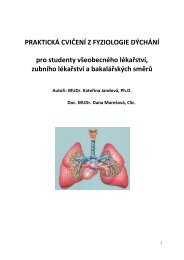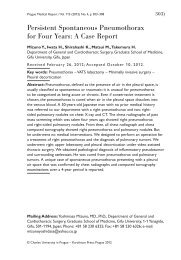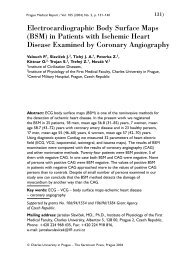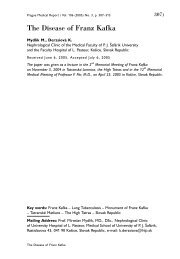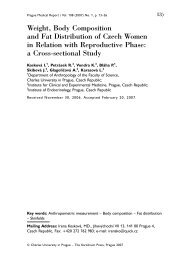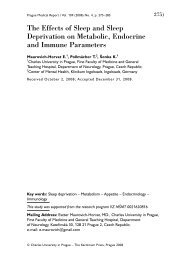Case Report: Pelvic Actinomycosis - Prague Medical Report
Case Report: Pelvic Actinomycosis - Prague Medical Report
Case Report: Pelvic Actinomycosis - Prague Medical Report
You also want an ePaper? Increase the reach of your titles
YUMPU automatically turns print PDFs into web optimized ePapers that Google loves.
44) <strong>Prague</strong> <strong>Medical</strong> <strong>Report</strong> / Vol. 113 (2012) No. 1, p. 44–48<br />
<strong>Case</strong> <strong>Report</strong>: <strong>Pelvic</strong> <strong>Actinomycosis</strong><br />
Maxová K. 1 , Menzlová E. 1 , Kolařík D. 2 , Dundr P. 3 , Halaška M. 1<br />
1 Department of Obstetrics and Gynaecology, First Faculty of Medicine,<br />
Charles University in <strong>Prague</strong> and Hospital Bulovka, <strong>Prague</strong>, Czech Republic;<br />
2 Department of Gynaecology and Obstetrics, Third Faculty of Medicine,<br />
Charles University in <strong>Prague</strong> and Institute for the Care of Mother and Child,<br />
<strong>Prague</strong>, Czech Republic;<br />
3 Institute of Pathology, First Faculty of Medicine, Charles University in <strong>Prague</strong><br />
and General University Hospital in <strong>Prague</strong>, <strong>Prague</strong>, Czech Republic<br />
Recei ved Jul y 30, 2011; Accepted January 16, 2012.<br />
Key words: <strong>Actinomycosis</strong> – Tumour – Antibiotics – Urinary bladder<br />
Abstract: A case of pelvic actinomycosis is presented. The patient is 42-year-old<br />
female with a 5 weeks history of pelvic pain. An intrauterine device (IUD) was taken<br />
out 3 weeks ago. There is a lump length 9 cm between rectus muscles. Ultrasound,<br />
magnetic resonance imaging (MRI) and histology are used to make the diagnosis.<br />
<strong>Actinomycosis</strong> can mimic the tumour disease. The definitive diagnosis requires<br />
positive anaerobic culture or histological identification of actinomyces granulas.<br />
A long lasting antibiotic therapy is performed.<br />
Mailing Address: Kateřina Maxová, MD., Department of Obstetrics<br />
and Gynaecology, First Faculty of Medicine, Charles University in <strong>Prague</strong><br />
and Hospital Bulovka, Budínova 2, 180 00 <strong>Prague</strong> 8, Czech Republic;<br />
Phone: +420 266 083 236; e-mail: kacabamaxa@centrum.cz<br />
Maxová © Charles K.; University Menzlová in E.; <strong>Prague</strong> Kolařík – D.; Karolinum Dundr P.; Press, Halaška <strong>Prague</strong> M. 2012
<strong>Prague</strong> <strong>Medical</strong> <strong>Report</strong> / Vol. 113 (2012) No. 1, p. 44–48<br />
45)<br />
Introduction<br />
<strong>Actinomycosis</strong> is a chronic infectious disease caused by the microorganism of<br />
genera Actinomyces. Actinomyces is a part of normal mucosal flora in oropharynx,<br />
gastrointestinal tract (GIT) and female genital tract. It causes infection only when<br />
the surface of the tissue is broken, mainly due to the presence of foreign body<br />
(intrauterine device – IUD) or failure in integrity of mucosa. The infection spreads<br />
contiguously crossing the anatomic barriers. Distant lesions can be formed.<br />
<strong>Actinomycosis</strong> can be mistaken for malignant tumour in the pelvis. The definitive<br />
diagnosis requires positive anaerobic culture or histological identification of<br />
actinomyces granulas. Antibiotics for several weeks to months are required.<br />
Material and Methods<br />
A 42-year-old female was referred to our Department of Obstetrics and<br />
Gynaecology for 5 weeks lasting pain in the area below the navel. Her gynecologist<br />
thought of urinary tract infection therefore prescribed antibiotics. The treatment<br />
had no effect on pain. Her IUD was removed 3 weeks before this treatment that<br />
had been inserted before 20 months. It was already the second IUD multi load.<br />
The first one had been inserted for 40 months and was replaced by the second one<br />
without break. She negated fatigue, fever, loss of weight, nausea, dysuria and also<br />
gynecological discharge. The stool was regular. There was nothing important in her<br />
medical history.<br />
Laboratory investigation: leucocytes 9.1, C-reactive protein (CRP) 6.4. Urine<br />
culture was sterile. An elongated lump was palpable between the rectus muscles<br />
below the navel and measured 9×4 cm. The lump was solid, fixed and painless.<br />
The ultrasound examination identified a non-homogenous infiltrate located in the<br />
5.8 cm<br />
Figure 1 – Magnetic resonance imaging<br />
scan (arrow heads to the lump).<br />
<strong>Case</strong> <strong>Report</strong>: <strong>Pelvic</strong> <strong>Actinomycosis</strong>
46) <strong>Prague</strong> <strong>Medical</strong> <strong>Report</strong> / Vol. 113 (2012) No. 1, p. 44–48<br />
Figure 2 – Suspicious focus<br />
in the urinary bladder.<br />
abdominal wall and the urinary bladder apex. The size was 92 mm, thickness 48 mm,<br />
width 72 mm.<br />
Magnetic resonance imaging (MRI) proved an oval lump size 58×36×35 mm which<br />
spread cranially between the rectus muscles toward the navel along the medial<br />
umbilical ligament. The lump infiltrated the adjacent peritoneum, lymphatic nodes<br />
weren’t enlarged. The suspicion for tumorous process of the small pelvis was raised<br />
(Figure 1).<br />
Cystoscopy was performed and a suspicious focus measuring 7×7 mm was found<br />
in the vertex of the urinary bladder. There were yellowish substances at the top<br />
of the focus, thus, we gave a thought to actinomycosis. Samples for microscopic<br />
examination were taken (Figure 2).<br />
The Tru-cut biopsy was performed and the diagnosis after histological examination<br />
of the actinomycosis was confirmed.<br />
The patient was admitted to our Department of Obstetrics and Gynaecology<br />
for intensive parenteral antibiotic treatment. The type of antibiotics was consulted<br />
with reputable antibiotic centres. Penicillin G 20 million units was given for 21 days<br />
followed by Procaine Penicillin 3 million units daily.<br />
After 3 days using the Procaine Penicillin the allergic reaction in the form of<br />
the maculopapulose exanthema appeared. We changed the antibiotics to peroral<br />
Duomox 1 g daily. The effect of therapy was controlled by ultrasound examination.<br />
The focus had a half of the previous size after 4 weeks of the treatment. After<br />
12 weeks a quarter (23×15×21 mm).<br />
The antibiotic administration continues without hospitalization and the treatment<br />
will last several months. <strong>Pelvic</strong> ultrasound scan is performed on monthly basis and<br />
liver enzymes are checked also monthly, cystoscopy is performed every two<br />
months.<br />
Maxová K.; Menzlová E.; Kolařík D.; Dundr P.; Halaška M.
<strong>Prague</strong> <strong>Medical</strong> <strong>Report</strong> / Vol. 113 (2012) No. 1, p. 44–48<br />
47)<br />
Discussion<br />
<strong>Actinomycosis</strong> is a slowly progressing chronic infectious disease caused by Grampositive<br />
anaerobic bacteria genera Actinomyces, most frequently Actinomyces israelli.<br />
It is part of normal flora in oropharynx, GIT and female genital tract (Brown, 1973).<br />
If there is failure in integrity of mucosa microorganism can pass this barrier into the<br />
tissues and can form abscesses with surrounding granulation. The infection spreads<br />
contiguously crossing the anatomic barriers; hematogenous spread is less common<br />
(Makar et al., 1992). Nevertheless, distant lesions can be formed. The likelihood of<br />
colonization rises with increasing duration of IUD (Curtis and Pine, 1981).<br />
The microorganisms multiply slowly creating microcolonies. They are surrounded<br />
by polymorphonuclear cells and are incrusted by calcium salts and sulphur granules<br />
formations not actually sulphur-containing but resembling such particles. These<br />
Figure 3 – Sulphur granules<br />
hematoxylin and eosin 250×.<br />
Figure 4 – Sulphur granules<br />
Warthin-Starry 400×.<br />
<strong>Case</strong> <strong>Report</strong>: <strong>Pelvic</strong> <strong>Actinomycosis</strong>
48) <strong>Prague</strong> <strong>Medical</strong> <strong>Report</strong> / Vol. 113 (2012) No. 1, p. 44–48<br />
granules contain progeny bacteria. The preliminary diagnosis can be made by<br />
examining these granules microscopically. The sulphur granules (up to 1 mm) are<br />
macroscopically yellow/brown particles with a cauliflower appearance at low<br />
magnification; they are characteristic for actinomycosis. Gram staining reveals the<br />
typical beaded, branched, Gram-positive filamentous rods (Figures 3 and 4).<br />
Based on the anatomic site of lesions four clinical forms are recognized:<br />
cervicofascial, thoracic, abdominal and pelvic. The microorganism causes the<br />
infection only when the tissue is broken; it requires the presence of foreign body<br />
(IUD) or failure in integrity of mucosa. The infection penetrates from perineum or<br />
abdominal wall into abdominal cavity and pelvic organs in pelvic or abdominal form<br />
(Koo et al., 2011). <strong>Actinomycosis</strong> can be then mistaken for malignant tumour. The<br />
definitive diagnosis requires positive anaerobic culture or histological identification of<br />
actinomyces granulas.<br />
Standard causal therapy: antibiotics for several weeks to months. Benzylpenicillin is<br />
the first choice; in the case of resistance or complications second one is macrolids.<br />
Concerning dosage, initial treatment with parenteral benzylpenicillin 10–20 million<br />
units daily for 4–6 weeks can be followed by phenoxymetylpenicillin 2–4 grams for<br />
at least 6–12 months, or parenteral aminopenicillin 50 mg/kg/day for 4–6 weeks can<br />
be followed by peroral aminopenicillin 500 mg/8 hours for 6 months. Dosage and<br />
treatment time depends on the scale of invasion, size of the lesion as well as on the<br />
compliance of the patient. Surgical intervention is limited to excision of abscesses<br />
and fistulas.<br />
Conclusion<br />
<strong>Pelvic</strong> actinomycosis can be mistaken with malignancy. We must think on this<br />
diagnosis especially in women using IUD.<br />
References<br />
Brown, J. R. (1973) Human actinomycosis. A study of 181 subjects. Hum. Pathol. 4, 319–330.<br />
Curtis, E. M., Pine, L. (1981) Actinomyces in the vaginas of women with and without intrauterine<br />
contraceptive devices. Am. J. Obstet. Gynecol. 140, 880–884.<br />
Koo, Y. J., Kwon, Y. S., Shim, J. U., Mok, J. E. (2011) Predictors associated with severity of pelvic<br />
actinomycosis. J. Obstet. Gynaecol. Res. 37(12), 1792–1796.<br />
Makar, A. P., Michielsen, J. P., Boeckx, G. J., Van Marck, E. A. (1992) Primary actinomycosis of the urinary<br />
bladder. Br. J. Urol. 70, 205–206.<br />
Maxová K.; Menzlová E.; Kolařík D.; Dundr P.; Halaška M.



